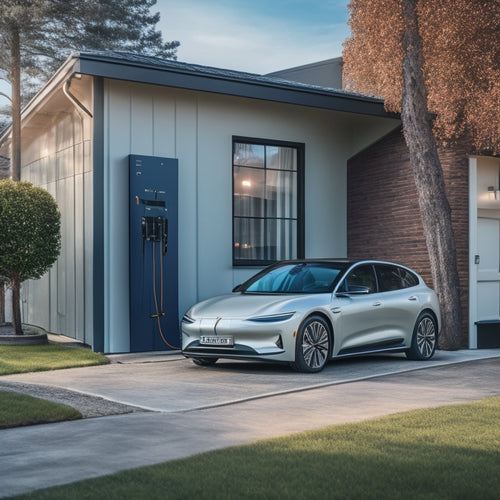
Solar Panels on the Side of Your House - Key Installation Considerations
Share
When installing solar panels on the side of your house, you'll need to assess shading and obstructions from trees, buildings, and roof elements like vents and chimneys, as even partial shading can greatly reduce energy production. You'll also need to choose the right panel type based on your energy needs and available space, balancing efficiency and cost. Moreover, verify your roof can support the added weight of solar panels and that the mounting system can withstand wind and snow. In addition, prioritize electrical safety and compliance with local codes, and consider aesthetics to guarantee a seamless integration with your home's design.
Key Takeaways
- Assess the side of your house for shading and obstructions from trees, buildings, and other structures to ensure optimal energy production.
- Choose the right solar panel type based on your energy needs, budget, and available installation space, considering monocrystalline, polycrystalline, and thin-film options.
- Ensure the side of your house can structurally support the added weight of solar panels, considering wind and snow resistance, and choose a suitable mounting system.
- Prioritize electrical safety by ensuring compliance with local building codes, proper wire management, and regular inspections to prevent system failure and fires.
- Consider the aesthetic impact of solar panels on your home's appearance, reviewing panel color, frame style, and mounting system for seamless integration with your house's design.
Assessing Shading and Obstructions
When evaluating your property for solar panel installation, examining shading and obstructions is a critical step that can greatly impact the system's performance.
You'll need to assess the sun's path across your roof throughout the day and year, considering seasonal changes that affect the angle and intensity of the sunlight. Even partial shading can considerably reduce energy production, so it's vital to identify potential obstructions.
Take note of trees, buildings, and other structures that may cast shadows on your roof.
Consider the height and location of these obstructions, as well as their potential growth or movement over time.
You'll also want to examine your roof's design, including vents, skylights, and chimneys, which can create shade or obstruction.
Choosing the Right Panel Type
Selecting the right solar panel type is a crucial decision that can make or break your system's performance. You'll want to take into account factors like panel efficiency, installation costs, and your specific energy needs.
Monocrystalline silicon panels offer high efficiency rates, but come at a higher cost. Polycrystalline silicon panels, on the other hand, provide a balance between efficiency and affordability. Thin-film panels are the most budget-friendly option, but their lower efficiency rates may require more panels to achieve the same energy output.
When evaluating panel types, contemplate your energy usage and the amount of space available for installation. If you have limited roof space, high-efficiency panels may be the better choice.
However, if you have ample space and are on a tighter budget, lower-efficiency panels could be the way to go. It's important to weigh the pros and cons of each option and reflect on your long-term energy goals.
Structural Integrity and Support
Three key elements guarantee your solar panel system operates safely and efficiently: a sturdy roof, a reliable mounting system, and a well-designed support structure.
As you prepare to install solar panels on the side of your house, you must confirm that your roof can support the added weight of the panels. You'll need to assess your roof's load capacity to determine if it can handle the weight of the panels, as well as withstand environmental factors like wind and snow.
When it comes to mounting options, you have several choices. You can opt for a fixed-mount system, which attaches directly to your roof, or a tracking system, which allows the panels to adjust to the sun's movement.
Regardless of the mounting option you choose, it's essential to verify that the system is designed to support the weight of the panels and withstand various environmental conditions.
A well-designed support structure will provide a secure foundation for your solar panel system, giving you peace of mind and ensuring peak performance.
Electrical and Safety Considerations
Your solar panel system's electrical components are just as vital as its structural foundation. As you investigate the possibility of installing solar panels on the side of your house, it's important to prioritize electrical and safety considerations.
When it comes to electrical components, you'll need to guarantee that your system meets local building codes and regulations. This includes wire management, which involves organizing and securing wires to prevent damage, overheating, or electrical shock.
Improper wire management can lead to system failure, fires, or even electrical shock.
To guarantee a safe and compliant installation, keep the following in mind:
- Verify that your system meets local building codes and regulations, such as the National Electric Code (NEC).
- Confirm that your installation team follows proper wire management practices to prevent electrical hazards.
- Conduct regular inspections and maintenance to identify and address potential electrical issues before they become safety hazards.
Aesthetics and Neighborhood Covenants
As you guarantee your solar panel system meets electrical and safety standards, it's equally important to reflect on how the installation will impact your home's appearance and comply with neighborhood regulations.
A well-designed solar panel system can enhance your home's curb appeal, but a poorly designed one can detract from it. Ascertain your solar panels are installed in a way that achieves design harmony with your home's structure and surrounding scenery. Consider factors like panel color, frame style, and mounting system to guarantee a seamless integration.
Additionally, review your neighborhood guidelines to confirm compliance with local regulations. Some neighborhoods have covenants, conditions, and restrictions (CC&Rs) that govern exterior modifications, including solar panel installations.
Verify that your installation meets these requirements to avoid potential disputes or penalties. By considering aesthetics and neighborhood covenants, you can enjoy the benefits of solar energy while maintaining your home's appeal and avoiding potential issues with your neighbors or homeowners' association.
Frequently Asked Questions
Can I Mix Old and New Solar Panels on My House?
You're wondering if you can mix old and new solar panels on your house. While it's technically possible, you'll need to guarantee panel compatibility to avoid installation challenges, as mismatched panels can reduce system efficiency and even cause safety issues.
Do Solar Panels Work During a Power Outage?
You're wondering if solar panels work during a power outage - the answer is no, unless you have a solar energy storage system, which mitigates the power outage impact, allowing you to capture solar energy even when the grid is down.
Will Solar Panels Increase My Property Taxes?
While you're reaping the solar energy benefits, you're likely wondering if they'll increase your property taxes. Fortunately, your property tax assessment usually won't be heavily impacted, as the added value is often offset by local incentives, so you can bask in the savings.
Can I Install Solar Panels Over Existing Roofing Material?
You'll need to assess your roofing material's compatibility with solar panels, as some materials, like asphalt shingles, may not be suitable. Research installation techniques, like raised racks or adhesive mounts, to guarantee a secure and efficient installation that won't compromise your roof's integrity.
Do Solar Panels Require Regular Cleaning or Maintenance?
"An ounce of prevention is worth a pound of cure." You'll need to clean your solar panels regularly to guarantee ideal energy output, aiming for a cleaning frequency of every 6-12 months, and follow maintenance tips like inspecting for debris and loose connections.
Conclusion
As you contemplate installing solar panels on the side of your house, remember that a stitch in time saves nine. By carefully evaluating shading and obstructions, choosing the right panel type, ensuring structural integrity and support, and addressing electrical and safety factors, you'll be well on your way to utilizing the power of the sun. Don't forget to think about aesthetics and neighborhood covenants to avoid a costly misstep. With careful planning, your solar panel installation will be a bright spot in your energy-efficient future.
Related Posts
-

5 Essential Tips for Buying EV Charging Systems Online
When purchasing an EV charging system online, you'll want to make sure you're making an informed decision. First, det...
-

5 Ways Bike Sharing Boosts Urban Sustainability
As you explore bike-sharing options, you'll discover five ways it boosts urban sustainability. By reducing congestion...
-

Why Cities Need Smart Charging Infrastructure Now
You're about to experience a tidal wave of electric vehicles hitting your city's streets, and it's essential you're p...


